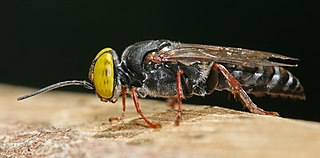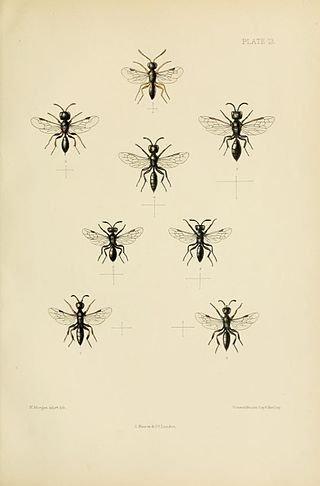
The superfamily Apoidea is a major group within the Hymenoptera, which includes two traditionally recognized lineages, the "sphecoid" wasps, and the bees. Molecular phylogeny demonstrates that the bees arose from within the traditional "Crabronidae", so that grouping is paraphyletic, and this has led to a reclassification to produce monophyletic families.

Myrtaceae, the myrtle family, is a family of dicotyledonous plants placed within the order Myrtales. Myrtle, pōhutukawa, bay rum tree, clove, guava, acca (feijoa), allspice, and eucalyptus are some notable members of this group. All species are woody, contain essential oils, and have flower parts in multiples of four or five. The leaves are evergreen, alternate to mostly opposite, simple, and usually entire. The flowers have a base number of five petals, though in several genera, the petals are minute or absent. The stamens are usually very conspicuous, brightly coloured, and numerous.

The Crabronidae are a large paraphyletic group of wasps, including nearly all of the species formerly comprising the now-defunct superfamily Sphecoidea. It collectively includes well over 200 genera, containing well over 9000 species. Crabronids were originally a part of the Sphecidae, but the latter name is now restricted to a separate family based on what was once the subfamily Sphecinae. Several of the subfamilies of the Crabronidae are often treated as families in their own right, as is true of the most recent phylogenies.

Malpighiaceae is a family of flowering plants in the order Malpighiales. It comprises about 73 genera and 1315 species, all of which are native to the tropics and subtropics. About 80% of the genera and 90% of the species occur in the New World and the rest in the Old World.

The Spheciformes is a paraphyletic assemblage of insect families which collectively comprise the "sphecoid wasps". Larvae are carnivorous.

Astatidae is a cosmopolitan family of solitary wasps, peculiar for their males having very large compound eyes that broadly meet at the top of the head. The largest genus in this family is Astata, with about half of more than 160 species in the family.

Pemphredonidae is a family of aphid wasps formerly treated as the subfamily Pemphredoninae. There are 19 genera and 556 described species in the family.

Spilomena is a genus of aphid wasps in the family Pemphredonidae. The 86 species are found worldwide being represented in the Palearctic, Nearctic, Afrotropical, Neotropical, Australasian, and Indomalayan realms.

Psen is a genus of aphid wasps in the family Psenidae. There are at least 90 described species in Psen.

Psenidae is a family of aphid wasps in the superfamily Apoidea formerly treated as the tribe Psenini. There are 12 genera and at least 485 described species of Psenidae.

Pepsini is a tribe of spider wasps in the family Pompilidae.
Ammoplanus is a genus of aphid wasps in the family Ammoplanidae. There are more than 50 described species in Ammoplanus.
Palmodes is a genus of thread-waisted wasps in the family Sphecidae. There are more than 20 described species in Palmodes.
Didineis is a genus of wasps in the family Crabronidae. There are more than 20 described species in Didineis.
Parammoplanus is a genus of aphid wasps in the family Ammoplanidae. There are about 19 described species in Parammoplanus.
Pulverro is a genus of aphid wasps in the family Ammoplanidae. There are about 13 described species in Pulverro.

Ammoplanops is a genus of aphid wasps in the family Ammoplanidae. There are about 15 species described in the genus Ammoplanops.

Lestiphorus is a genus of sand wasps in the family Crabronidae. There are about 18 described species in Lestiphorus.
Diploplectron is a genus of wasps in the family Astatidae. There are more than 20 described species in Diploplectron.

Gorytina is a subtribe of sand wasps in the family Crabronidae. There are at least 20 genera and 370 described species in Gorytina.













